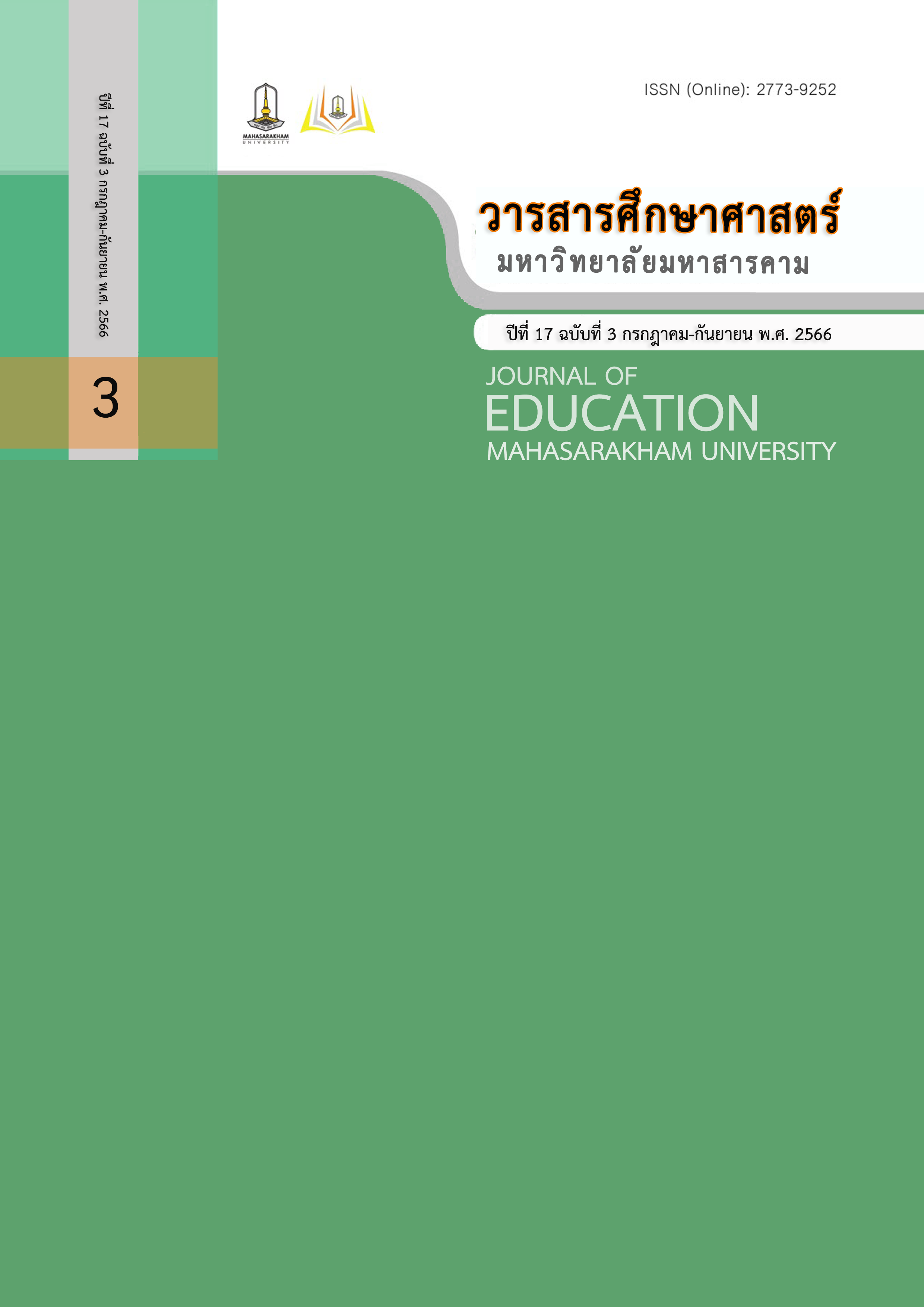การสกัดความรู้พัฒนาการเด็กไทยจากคู่มือเฝ้าระวังและส่งเสริมพัฒนาการเด็กและการจัดการตนเองขั้นสูง
Main Article Content
บทคัดย่อ
การวิจัยครั้งนี้มีวัตถุประสงค์เพื่อ 1) สกัดข้อมูลการประเมินจากคู่มือเฝ้าระวังและส่งเสริมพัฒนาการเด็ก (DSPM) ที่มีส่วนช่วยในการพัฒนาและทักษะการจัดการตนเองขั้นสูง (EF) 2) สร้างตัวชี้วัดพัฒนาการเด็กไทยโดยใช้ความรู้จากทักษะการจัดการตนเองขั้นสูง และ 3) บูรณาการความรู้ที่ได้จากคู่มือเฝ้าระวังและส่งเสริมพัฒนาการเด็ก และเครื่องมือตัวชี้วัดการจัดการตนเองขั้นสูง เพื่อเป็นองค์ความรู้ที่สามารถนำไปต่อยอดในการใช้งานในอนาคต การวิจัยครั้งนี้เป็นการวิจัยเชิงคุณภาพโดยนำเสนอองค์ความรู้ที่สกัดแล้วให้ผู้เชี่ยวชาญจำนวน 30 คน รับรองประสิทธิภาพและคุณภาพของข้อมูล การวิจัยครั้งนี้ใช้เชิงพรรณนาในการตีความของข้อมูล วิเคราะห์ข้อมูลโดยใช้คำอธิบายของปรากฏการณ์หนึ่ง ๆ และสรุปผลการวิจัยได้ดังนี้ 1) เกี่ยวกับการสกัดข้อมูลการประเมินจากคู่มือเฝ้าระวังและส่งเสริมพัฒนาการเด็ก ที่มีส่วนช่วยในการพัฒนาและทักษะการจัดการตนเองขั้นสูง ผู้เชี่ยวชาญเห็นพ้องต้องกันว่าควรตัดประเด็นเรื่องเพศออก 1 รายการ และเหลือทั้งหมด 27 รายการ 2) สำหรับเครื่องมือและตัวชี้วัดที่สร้างขึ้น ตัวชี้วัดการพัฒนาการของทักษะการรู้คิดอยู่ในระดับสูง และการจัดกลุ่มทักษะทั้งหมดมีคุณภาพและความแม่นยำในระดับสูง 3) ในการนำเสนอและรับรองคุณภาพการสกัดข้อมูล ผู้เชี่ยวชาญมีความคิดเห็นค่อนข้างคล้ายคลึงกัน กล่าวคือ องค์ความรู้ที่สกัดออกมามีคุณภาพเป็นที่ยอมรับและมีประสิทธิภาพดี สามารถนำไป พัฒนาต่อยอดเป็นองค์ความรู้ในการพัฒนาเครื่องมือ เพื่อระบุและส่งเสริมพัฒนาการเด็กที่มีคุณภาพ
Downloads
Article Details

อนุญาตภายใต้เงื่อนไข Creative Commons Attribution-NonCommercial-NoDerivatives 4.0 International License.
เอกสารอ้างอิง
Adlof, S. M., & Hogan, T. P. (2018). Understanding dyslexia in the context of developmental language disorders. Language, speech, and hearing services in schools, 49(4), 762-773. [DOI:10.1044/2018_LSHSS-DYSLC-18-0049].
Akyurek, G., & Bumin, G. (2019). An investigation of executive function in children with dyslexia. Psychiatry and Behavioral Sciences, 9(1-2), 10-17.
Allen LR, Kelly BB, editors. (2015). Transforming the Workforce for Children Birth Through Age: A Unifying Foundation. National Academies Press (US). Retrieved from https://www.ncbi.nlm.nih.gov/books/NBK310536/.
Finegood, E.D., Blair, C. (2017). Poverty, Parent Stress, and Emerging Executive Functions in Young Children. In: Deater-Deckard, K., Panneton, R. (eds) Parental Stress and Early Child Develฟopment. Springer, Cham. Retrieved from https://doi.org/10.1007/978-3-319-55376-4_8.
Hoskyn, M., Iarocci, G., & Young, A. R. (2017). Executive functions in children's everyday lives: A handbook for professionals in applied psychology. Oxford University Press. [DOI:10.1093/acprof:oso/9780199980864.001.0001]
Kanchana, S.; Kotchabhakdi, N.; Sirithongthaworn, S.; Isaranarug, S. (2015). Developmental Surveillance and Promotion Manual (DSPM); Chindasan Printing House: Ratchaburi, Thailand.
Huttenlocher, P. R. (2002). Neural Plasticity: The Effects of Environment on the Development of the Cerebral Cortex. Harvard University Press. Retrieved from https://doi.org/10.2307/j.ctv1khdr07.
Kajornrungsilp, S. (1995). A model curriculum for parent education in Thai society. Illinois State University.
Kanchana, S. (2015). Development promotion project in honor of His Majesty Thep Rattana Ratchasuda Siam Boromrajkumari. National Institute of Child Health Development, Department of Health.
Kirsten A. Quistberg, Ulrich Mueller. (2020). Prospective relations between kindergarteners’ executive function skills and their externalizing and internalizing behaviors. The Clinical Neuropsychologist, 34(4), pages 845-862.
Nejati, V., Salehinejad, M. A., Nitsche, M. A., Najian, A., & Javadi, A.-H. (2020). Transcranial direct current stimulation improves executive dysfunctions in ADHD: Implications for inhibitory control, interference control, working memory, and cognitive flexibility. Journal of Attention Disorders, 24(13), 1928-1943. https://doi.org/10.1177/1087054717730611
Nonaka, I., & Takeuchi, H. (1995). The knowledge creating company: How Japanese companies create the dynamics of innovation. Oxford University Press.
Noppakhun, C. (2018). Reflective thinking through sketchbook journals of teacher students of early childhood education of Suan Dusit University. Suan Dusit Graduate School Academic Journal, 14(3), 307-322.
Roberts, M.Y.; Curtis, P.R.; Sone, B.J.; & Hampton, L.H. (2019). Association of Parent Training With Child Language Development: A Systematic Review and Meta- analysis. JAMA Pediatr, 173, 671–680.
Srisaat, B. (2010). Preliminary research (7th ed.). Suwiriyasan. Thonghem, A., & Pattanapongthon, J. (2015). Smart kids to Thailand 4.0. Department of Health.
Wood, C., Kohli, S., Malcolm, E., Allison, C., & Shoaib, M. (2016). Subtypeselective nicotinic acetylcholine receptor agonists can improve cognitive flexibility in an 157 attentional set shifting task. Neuropharmacology, 105, 106-113. https://doi.org/10.1016/j.neuropharm.2016.01.006.
Zelazo, P.D., Blair, C.B., Willoughby, M.T., Larson, M., Higgins, E., & Sussman, A. (2017). Executive Function: Implications for Education. National Center for Education Research (NCER) and National Center for Special Education Research (NCSER). U.S. Department of Education.


